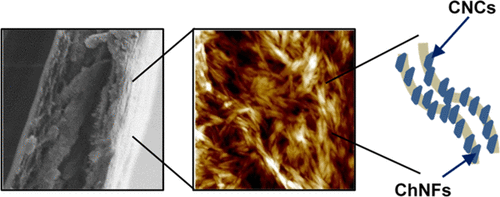当前位置:
X-MOL 学术
›
Biomacromolecules
›
论文详情
Our official English website, www.x-mol.net, welcomes your
feedback! (Note: you will need to create a separate account there.)
Controlling Barrier and Mechanical Properties of Cellulose Nanocrystals by Blending with Chitin Nanofibers.
Biomacromolecules ( IF 5.5 ) Pub Date : 2019-12-05 , DOI: 10.1021/acs.biomac.9b01268 Chinmay C Satam , Cameron W Irvin , Cameron J Coffey , Riley K Geran , Rogelio Ibarra-Rivera , Meisha L Shofner , J Carson Meredith
Biomacromolecules ( IF 5.5 ) Pub Date : 2019-12-05 , DOI: 10.1021/acs.biomac.9b01268 Chinmay C Satam , Cameron W Irvin , Cameron J Coffey , Riley K Geran , Rogelio Ibarra-Rivera , Meisha L Shofner , J Carson Meredith

|
Chitin nanofibers (ChNFs) and cellulose nanocrystals (CNCs) have been proposed as materials for renewable packaging with low O2 transmission that protect food, medicine, and electronics. A challenge in biomass-derived functional materials is tuning both barrier and mechanical properties, while minimizing process steps. A concept that merits additional study in this field is tuning of the barrier and mechanical properties by use of oppositely charged biomass-derived fibers, through interactions that support dense film formation. We report free-standing films formed by solution casting of blends of aqueous suspensions of CNCs and ChNFs with either low degree of acetylation (LChNFs, higher charge) or high degree of acetylation (HChNFs, lower charge). While neat CNC films had the highest O2 permeability (OP), the OP was lowered by 91% by addition of at least 25 wt % LChNFs to CNCs to an OP value near 1.7 cm3 μm/m2/d/kPa. Interestingly, blends of CNCs with less highly charged, larger HChNFs had equivalently lower OP as with LChNFs. The tensile strength and strain at break of blended ChNF/CNC films was optimal compared to neat cellulose or chitin when at least 50 wt % LChNFs or HChNFs were blended with CNCs. We show that the ability to tune properties of ChNF/CNC blends was coincident with the formation of aggregates of chitin and cellulose nanomaterials, which appear to support formation of dense layers of tortuous fiber networks.
中文翻译:

通过与几丁质纳米纤维混合控制纤维素纳米晶体的屏障和力学性能。
几丁质纳米纤维(ChNFs)和纤维素纳米晶体(CNCs)已被提议作为可再生包装的材料,具有低O2传输,可保护食品,药品和电子产品。来自生物质的功能材料的挑战是在最小化工艺步骤的同时调整阻挡层和机械性能。值得在该领域进行进一步研究的概念是通过使用带相反电荷的生物质衍生纤维,通过支持致密膜形成的相互作用来调节阻挡层和机械性能。我们报告了通过溶液浇铸CNCs和ChNFs的水悬浮液的混合物而形成的独立膜,这些混合物的乙酰化程度较低(LChNFs,较高电荷)或乙酰化程度较高(HChNFs,较低电荷)。纯净的CNC薄膜具有最高的O2渗透率(OP),通过向CNC控制器中添加至少25 wt%的LChNF,将OP值降低至91 cm3μm/ m2 / d2 / kPa,可将OP降低91%。有趣的是,与低电荷,较大的HChNFs混合的CNCs具有与LChNFs相当低的OP。当将至少50 wt%的LChNFs或HChNFs与CNCs混合时,与纯纤维素或几丁质相比,混合的ChNF / CNC薄膜的拉伸强度和断裂应变最佳。我们表明,调节ChNF / CNC共混物性能的能力与几丁质和纤维素纳米材料聚集体的形成相吻合,这似乎支持形成曲折纤维网络的致密层。当将至少50 wt%的LChNFs或HChNFs与CNCs混合时,与纯纤维素或几丁质相比,混合的ChNF / CNC薄膜的拉伸强度和断裂应变最佳。我们表明,调节ChNF / CNC共混物性能的能力与几丁质和纤维素纳米材料聚集体的形成相吻合,这似乎支持形成曲折纤维网络的致密层。当将至少50 wt%的LChNFs或HChNFs与CNCs混合时,与纯纤维素或几丁质相比,混合的ChNF / CNC薄膜的拉伸强度和断裂应变最佳。我们表明,调节ChNF / CNC共混物性能的能力与几丁质和纤维素纳米材料聚集体的形成相吻合,这似乎支持形成曲折纤维网络的致密层。
更新日期:2019-12-05
中文翻译:

通过与几丁质纳米纤维混合控制纤维素纳米晶体的屏障和力学性能。
几丁质纳米纤维(ChNFs)和纤维素纳米晶体(CNCs)已被提议作为可再生包装的材料,具有低O2传输,可保护食品,药品和电子产品。来自生物质的功能材料的挑战是在最小化工艺步骤的同时调整阻挡层和机械性能。值得在该领域进行进一步研究的概念是通过使用带相反电荷的生物质衍生纤维,通过支持致密膜形成的相互作用来调节阻挡层和机械性能。我们报告了通过溶液浇铸CNCs和ChNFs的水悬浮液的混合物而形成的独立膜,这些混合物的乙酰化程度较低(LChNFs,较高电荷)或乙酰化程度较高(HChNFs,较低电荷)。纯净的CNC薄膜具有最高的O2渗透率(OP),通过向CNC控制器中添加至少25 wt%的LChNF,将OP值降低至91 cm3μm/ m2 / d2 / kPa,可将OP降低91%。有趣的是,与低电荷,较大的HChNFs混合的CNCs具有与LChNFs相当低的OP。当将至少50 wt%的LChNFs或HChNFs与CNCs混合时,与纯纤维素或几丁质相比,混合的ChNF / CNC薄膜的拉伸强度和断裂应变最佳。我们表明,调节ChNF / CNC共混物性能的能力与几丁质和纤维素纳米材料聚集体的形成相吻合,这似乎支持形成曲折纤维网络的致密层。当将至少50 wt%的LChNFs或HChNFs与CNCs混合时,与纯纤维素或几丁质相比,混合的ChNF / CNC薄膜的拉伸强度和断裂应变最佳。我们表明,调节ChNF / CNC共混物性能的能力与几丁质和纤维素纳米材料聚集体的形成相吻合,这似乎支持形成曲折纤维网络的致密层。当将至少50 wt%的LChNFs或HChNFs与CNCs混合时,与纯纤维素或几丁质相比,混合的ChNF / CNC薄膜的拉伸强度和断裂应变最佳。我们表明,调节ChNF / CNC共混物性能的能力与几丁质和纤维素纳米材料聚集体的形成相吻合,这似乎支持形成曲折纤维网络的致密层。











































 京公网安备 11010802027423号
京公网安备 11010802027423号